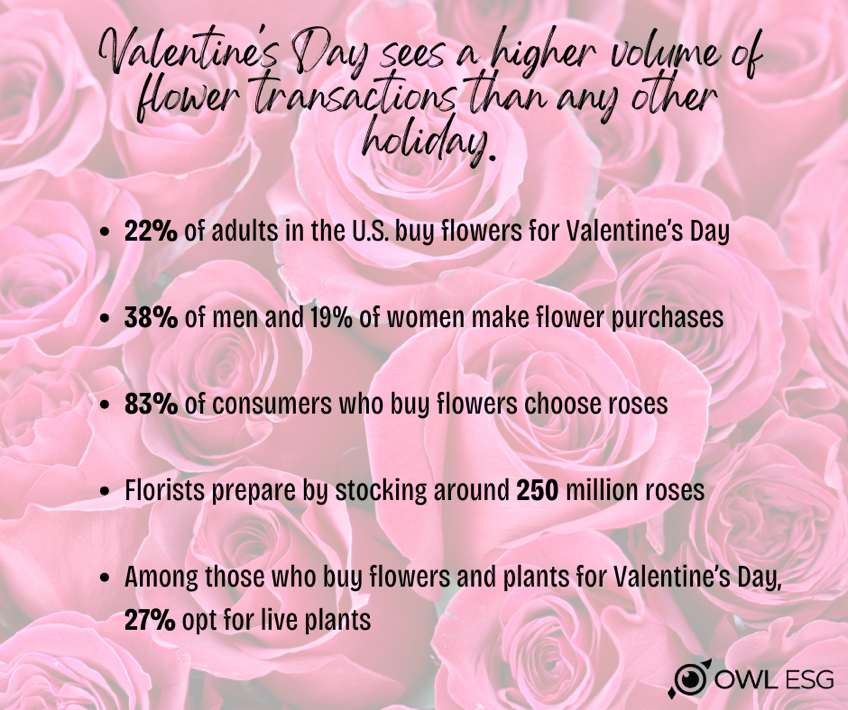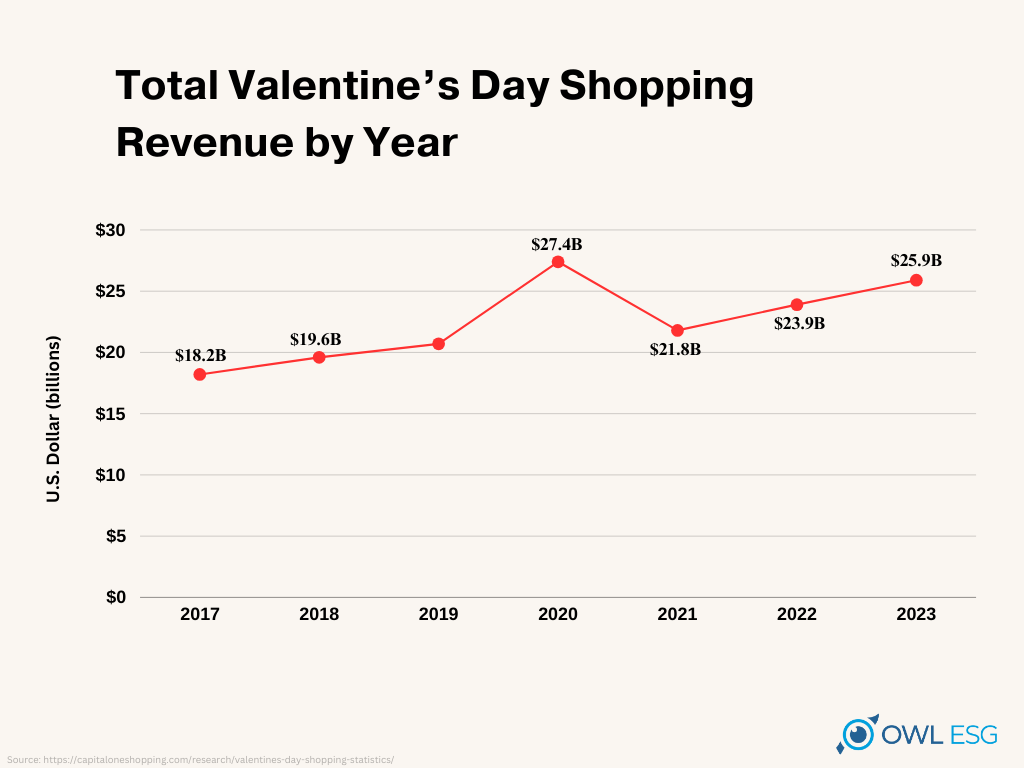The Green Dilemma: Unwrapping the Environmental Impact of Valentine’s Day
Originating in Ancient Greece, the tradition of celebrating February 14 was a day dedicated to Cupid, AKA the god of love, where people brought offerings to honor him. This sentiment carried through to the Christan celebration of St. Valentine, and from there, Valentine’s Day was born. While the sentiment is heartwarming, Valentine’s Day brings with it several potentially concerning environmental impacts. From the production and transportation of flowers to the excessive packaging of gifts, Valentine’s Day leaves a footprint that cannot be ignored.
The Floral Footprint
A bouquet of flowers, usually the quintessential dozen red roses, is probably one of the most iconic symbols of Valentine’s Day. The demand for freshly cut flowers during this season leads to an influx of cultivation, often involving resource-intensive practices.
For instance, massive amounts of water, pesticides, and fertilizers are used to grow the perfect blooms, contributing to soil degradation and water pollution. In fact, it’s estimated that roughly 20 percent of the chemicals employed in the floriculture industry in developing countries are either prohibited or untested in the U.S. Additionally, the carbon footprint of transporting flowers from their country of origin to local markets is substantial, especially when considering air freight for perishable goods.
While roses remain the most bought flower during this holiday, almost all are flown from Latin America, specifically Columbia, Kenya, Ethiopia, and Ecuador. According to the International Council on Clean Transportation, the importation of flowers burns roughly 114 million liters (about 30115608 gal) of fuel, emitting approximately 360,000 metric tons of carbon dioxide into the atmosphere.

Instead of buying commercial flowers, support your local florists. Many grow their flowers or are part of a local collective so they can source them from different florists or growers in your state.
Sustainable practices
Debra Prinzing, author of The 50 Mile Bouquet, founded the Slow Flowers movement, an initiative which advocates for the purchase of locally grown, in-season flowers from small-scale producers. Slow Flowers features a directory with over 700 growers across the U.S and Canada. While many of them will have flowers ready for Valentine’s Day, most won’t be roses. Instead, they offer “early spring crops that can be grown in greenhouses,” such as ranunculus, anemones, tulips, narcissus, and hellebores.
It’s not just American farms that prioritize sustainability. In Ecuador and Colombia, several certification programs assist consumers and florists in identifying flowers from farms that adhere to specific labor or environmental standards, which are equivalent to “organic” and “cruelty-free” certifications commonly seen in grocery stores.
Ximena Franco is the director of FlorVerde Sustainable Flowers, a Colombian organization among the certification groups. According to Franco, 92 growers in the Bogotá region adhere to FlorVerde’s certification standards, which encompass regulations on plant origins, energy efficiency, carbon footprints, and labor practices.
The organization’s comprehensive approach involves measuring growers’ carbon footprints and addressing various aspects like contamination prevention, recycling, water recirculation, and composting. The aim is to establish a circular agriculture system where contamination and carbon emissions are minimized.
Carbon-intensive indulgences
Beyond flowers and gifts, the environmental impact of indulging in Valentine’s Day extends to extravagant dinners, travel, and other activities. Restaurants that serve special menus during certain holidays, including Valentine’s Day, may source ingredients from distant locations, contributing to carbon emissions and greenhouse gases. Similarly, couples often embark on romantic getaways, adding to the overall carbon footprint associated with travel.
This Valentine’s Day, show your love by opting for restaurants that serve locally sourced food. Or, if you’re wanting to have a romantic night away, small inns and bed and breakfasts are a great choice that offer eco-friendly products/services and materials. Additionally, you get to experience a more personal atmosphere, all while supporting a local business.
Over-Packaging Predicament
Romantic gifts are an integral part of many people’s Valentine’s Day, bringing an avalanche of packaging waste. Excessive wrapping, plastic ribbons, and non-recyclable materials contribute to the already alarming global waste crisis.
From heart-shaped plastic containers to elaborate gift boxes, the environmental impact of such packaging is far-reaching. Considering that most of this packaging is discarded shortly after gifts are opened, the environmental consequences are not only immediate but long-lasting, with most waste entering landfills.

While chocolate remains a timeless Valentine’s Day present, not all share the same commitment to sustainability. To enhance the eco-friendliness of your Valentine’s Day celebration, choose brands that prioritize ethical sourcing, adhere to fair trade practices, and utilize sustainable packaging.
Ideally, choose chocolates packaged in recycled materials; alternatively, consider packaging made from paper, cardboard, or aluminum foil. Ateer clear of chocolates encased in molded plastic or individually wrapped in plastic, as they’re less likely to be recyclable.
Eco-Friendly Alternatives
Valentine’s Day is extremely commercialized, showcasing a variety of chocolates, cards, flowers, and stuffed animals in stores. Despite the joy from gift exchanges, the environmental repercussions are significant. In fact, the cumulative environmental impact results in carbon emissions exceeding those generated by driving around the world 3,933 times.
Fortunately, there are ways to celebrate love while minimizing the environmental impact of Valentine’s Day.
- Choose locally sourced and seasonal flowers to cut down on transportation-related carbon emissions.
- Opt for gifts with minimal or recyclable packaging to reduce waste.
- Prioritize experiences over material possessions, such as cooking a romantic meal or enjoying a nature hike.
- Support eco-friendly and sustainable businesses.
Valentine’s Day, a beautiful celebration of love, provides an opportunity to share that love with our fellow humans and our planet. By being mindful of the environmental impact associated with traditional celebrations, individuals can make conscious choices to reduce their ecological footprint.
Embracing sustainable alternatives and adopting eco-friendly practices can help ensure that expressions of love on Valentine’s Day don’t come at the expense of the environment. As we cherish our loved ones, let us also extend that love to the planet we call home.




